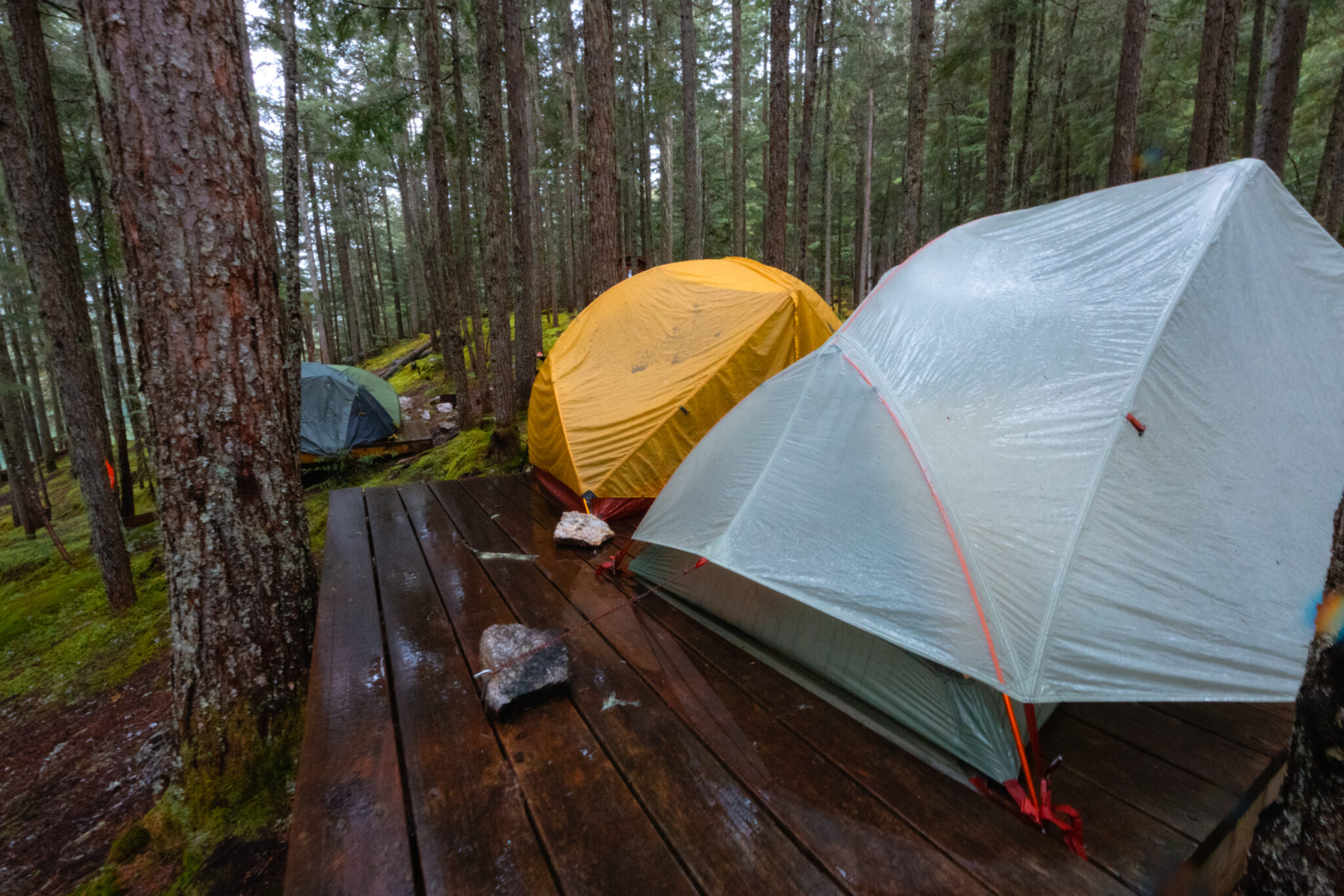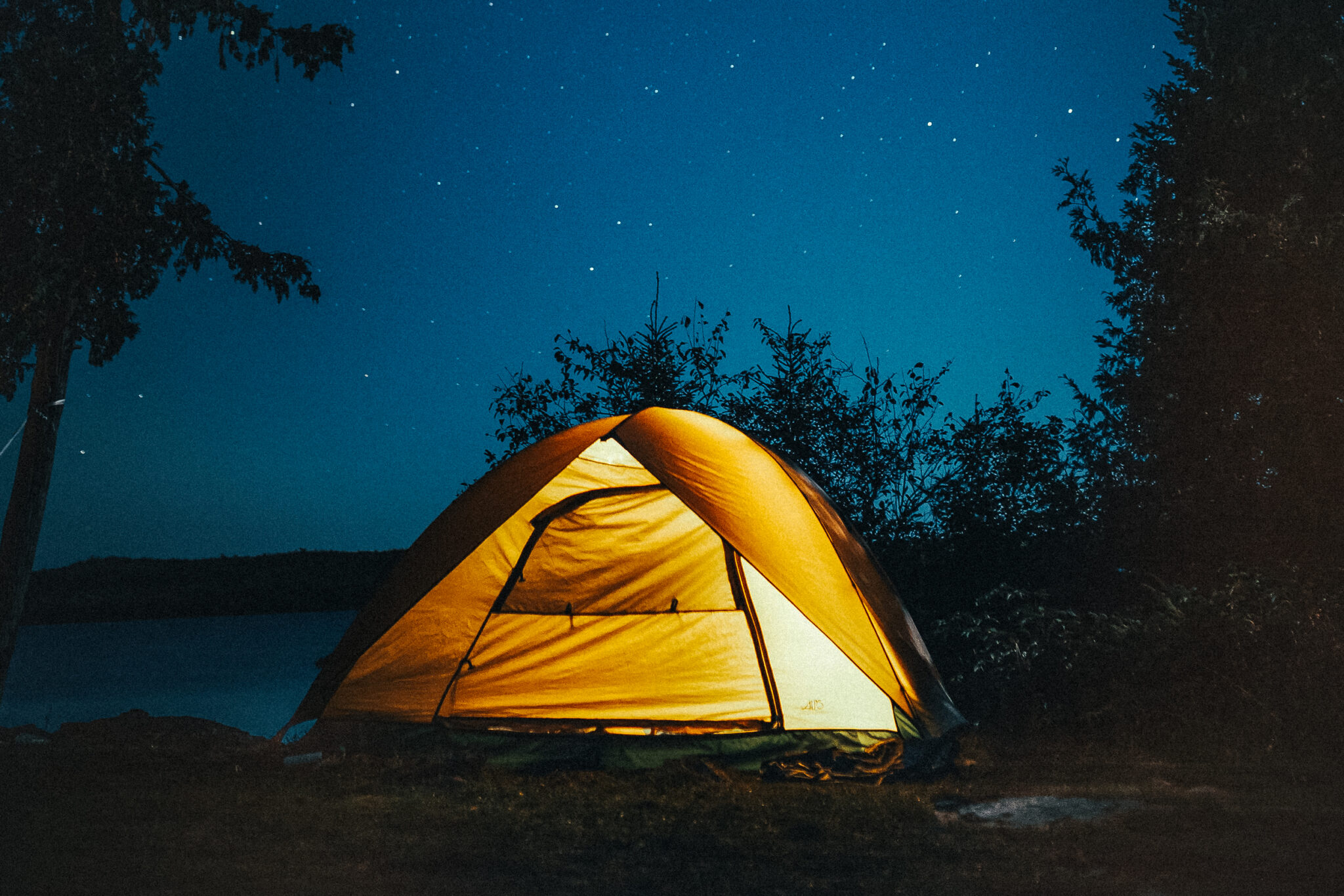Camping in the Rain: Tips & Gear

Let’s face it, camping in the rain sounds like a nightmare if you’re not ready. Wet clothes, soggy tents, and gloomy vibes? Hard pass. But guess what? With a little prep, it can actually be awesome!
Picture this: slowing down, savoring a warm meal like it’s the best thing you’ve ever had, and coming home with a hilarious story to share. Surviving (and actually enjoying) a rainy camping trip is totally possible!
So when the forecast calls for rain, don’t bail on your plans or sulk in your tent. Embrace the adventure! You’re not made of sugar; you won’t melt. These tips will help you turn a wet camping trip into one you’ll never forget. So let’s get into it.
Camping in the Rain? You Got This!
Prepping for a rainy camping trip starts way before you hit the trail. If you wait until those storm clouds show up, you’re asking for a bad time. But no stress, you’re here and you’re about to nail this!
Rainy Camping Gear Must-Haves
Camping in the rain is a lot different than regular camping, but the right gear makes it a whole lot easier. You don’t need to break the bank with super fancy gear, but make sure you do pack these essentials:
- A solid tent
- Waterproof tarps
- Paracord or rope
- A rain jacket or poncho (Black Diamond and KUHL make awesome ones!)
- Waterproof matches
- Waterproof bags or containers
- Extra clothes
Pro Tip: Need gear in a pinch? Amazon Prime has your back with two-day delivery which is perfect for those last-minute camping prep sessions!
Check the Weather Forecast
Keep an eye on the weather as your trip gets closer. Apps like The Weather Network, WeatherBug®, or AccuWeather are great for updates, especially in unpredictable areas.
Even if it looks sunny, always pack rain gear. A little prep (hello, extra tarps!) will go a long way in making sure you’re not in for a soggy trip.
If severe weather like thunderstorms are in the forecast though, consider rescheduling because there’s a big difference between camping in a drizzle and dangerous conditions!
Watch for Storm Clues
Keep an eye out for storm clues like eerie calm, gusty winds, or animals acting weird. If it feels like a storm’s brewing, secure your gear and get it under cover before the rain hits.
Don’t Forget Tarps & Paracord
Tarps are your rainy camping MVP! Use them to keep your gear, tent, and hangout space dry. Lightweight camping tarps are a great choice because they’re compact, versatile, and perfect for rain or shade. Pair them with paracord to create a cozy covered area or grab some adjustable poles if trees aren’t around.
You can also use a pop-up canopy for an easy, treeless option to keep the rain off your campsite
How to Dress for Rainy Camping
Staying dry and warm starts with the right clothes. Skip the cotton; it soaks up water like a sponge! Instead, go for moisture-wicking fabrics like polyester, nylon, fleece, or wool. They’ll keep you cozy, dry fast, and help you enjoy the rain without getting chilly.
Best Fabrics for Camping in the Rain
- Merino Wool: Wicks moisture, fights odours, and keeps you warm even when it’s wet.
- Polyester/Nylon: Lightweight, breathable, and dries fast. Perfect for base layers!
- Fleece: Cozy and quick-drying, great for layering under a waterproof jacket.
- Down: Super warm, but not good if it gets wet. Always pair it with a waterproof layer (click here for tips on buying down)
Cotton is a no-go for rainy camping. It stays wet, heavy, and cold which can be very dangerous in the outdoors.
Layering Tips
When you’re camping in the rain, layering your clothes the right way will keep you warm and dry. Here’s the simple formula for layering:
- Base Layer: Start with a moisture-wicking layer to keep sweat off your skin.
- Mid-Layer: Add a warm, insulating layer like fleece or wool.
- Outer Layer: Finish with a waterproof jacket or shell to block out the rain (Black Diamond and KUHL make awesome ones!)
Waterproof Your Tent
Nobody wants to wake up in a puddle during a camping trip! Even if your tent says it’s waterproof, giving it some extra love before your trip can save you from soggy gear and sleepless nights.
The following tips won’t magically turn an inexpensive non-waterproof tent into a completely waterproof one, but they can dramatically increase your tent’s water resistance for a regular camping season (if done correctly).
Waterproofing your tent is quick, easy, and defintely worth the effort to stay dry no matter what the weather throws your way. Here’s how to do it:
- Clean your tent
- Spray it with waterproofing spray
- Seal the seams with seam sealer
Before heading out, give your tent a little test drive by spraying a hose or dumping a bucket all over it. Regular waterproofing not only keeps you dry but also makes sure your tent’s ready to rock for future adventures. Better safe than soggy!
Recommended Waterproofing Products
Ready to make your tent rainproof? With the right products, it’s super easy to keep your tent dry and comfy no matter what the weather does. Here are some awesome waterproofing tools I swear by:
- Nikwax Tent and Gear SolarProof
- Kiwi Camp Dry Heavy Duty Water Repellent
- GEAR AID Seam Grip TF Tent Fabric Sealer
Keep Your Gear Dry When Camping in the Rain
Wet camping gear is a mood killer. Packing smart is the secret to an enjoyable, and dry, camping trip. Here’s how to make it happen:
- Waterproof Bags & Bins: Big plastic bins for car camping or lightweight stuff sacks for clothes and sleeping bags. Double up for extra protection, better safe than soggy!
- Backpacks with Rain Covers: Got a backpack? Grab a rain cover or pick a waterproof one to keep your stuff safe.
- Ziplocs & Garbage Bags: Stash electronics, medicine, and clothes in Ziplocs. Use garbage bags for big things like blankets, sleeping bags, or firewood. Bonus: perfect for stashing wet clothes later.
Always pack your gear properly and bring extra bags for wet clothes. A little prep goes a long way!
Choose a Rain-Safe Campsite
When picking a campsite, think ahead. What happens if the rain starts pouring? Will water flow through or pool under your tent? Are you too close to rivers or lakes that could rise? And don’t forget to check for dead trees that might crash down in a storm.
High ground is your best friend. You don’t need to scale a mountain, but avoid low spots where water loves to settle. A riverside view might be tempting, but camp well above the high-water mark unless you want a surprise wake-up call from a flash flood!
Tree cover can be helpful for hanging tarps and sheltering from rain, but beware of dripping branches and falling debris if the wind picks up. Plus, too much shade can leave your gear damp with no sunlight to dry it out.
For a dry and cozy setup, pitch your tent on slightly sloped high ground to keep water from pooling. And if your reserved spot isn’t great, don’t hesitate to ask if you can switch because it’s better safe than soggy.
How to Pitch Your Tent in the Rain
Setting up a tent is usually no big deal… until it starts raining. Then, it’s all about keeping everything dry from the start. Whether it’s a light drizzle or a full-on monsoon (okay, maybe not quite), these tips will have you pitching your tent like a pro no matter the weather.
- Pick the Perfect Spot: Look for level, elevated ground away from pooling water. Face the tent door away from the wind and, if you can, use your car as a windblock.
- String Up a Tarp: Hang a tarp above your tent before you start. Make sure it extends past the tent, doesn’t touch it, and slopes away to drain rain.
- Tarp the Bottom: Lay a tarp or tent footprint under your tent to keep out ground moisture, but tuck it completely under the tent to avoid water pooling.
- Don’t Forget the Rain Fly: Attach it securely for extra rain protection. Stake every corner and guyline tight to keep it from sagging or pooling water.
- Add a Vestibule or Door Mat: A vestibule creates a handy dry spot for wet gear. Use a mat or tarp at the entrance to keep mud out.
- Line the Inside: Lay a tarp or plastic sheet on the tent floor and extend it a bit up the walls for extra moisture protection.
Time to Deck Out Your Tent!
Your tent’s up, now let’s make the inside rain-ready. A little organization can be the difference between a cozy escape and a soggy mess. Follow these tips to keep things dry and comfy, even in a downpour.
- No Gear on Tent Walls: Keep your stuff off the walls to avoid water sneaking in through condensation. Pro tip: an inner tarp works wonders for extra protection.
- Wet Stuff Stays Outside: Shoes, wet clothes, and anything damp should hang out outside the tent. Keep the inside dry and happy!
Rainy Night? Sleep Tight!
Staying warm and dry is the secret to getting a good night’s sleep while camping in the rain. With the right gear, you’ll be cozy and wake up ready for more adventure.
Here’s how to set up your rain-proof snooze station:
- Sleeping Bag: Go for a synthetic bag; it stays warm even if it gets damp. Toss in some blankets or hand warmers for extra snuggly vibes.
- Bivy Sack: Slip your sleeping bag into a bivy sack for moisture protection and extra insulation.
- Sleeping Pad or Cot: Keep off the cold ground with a well-insulated sleeping pad or a cot (just don’t forget some padding if you go with a cot).
- Dry Clothes: Always change into dry clothes before bed. Your sleeping bag will thank you and so will you!
Let Your Tent Breathe!
Don’t let your tent turn into a steamy rainforest. Crack the vents or use a small fan to keep condensation in check. If the sun peeks out, ditch the rain fly, open everything up, and let your tent and gear soak in some fresh air. Fresh tent equals happy camper!
Create Your Rain-Proof Hangout Spot
With your tent set up, it’s time to build a cozy outdoor living room! Use tarps, paracord, or a pop-up canopy to create a dry, comfortable space where you can relax and enjoy the rain.
Want extra convenience? Connect the tarp over your tent to your living area so you can move back and forth without getting drenched. It’s like your own camping rain lounge!
Rain Shelter Must-Haves
With the right setup, your rain shelter will be the place to chill, rain or shine. Who says you can’t stay comfy and cozy in the great outdoors?
Here’s how to turn your shelter into a cozy hangout spot:
- String Lights or Lanterns: Brighten things up and add a warm, homey vibe
- Citronella Candles: Keep those pesky bugs far, far away
- Comfy Chairs: Go for a plush lounger, a lightweight seat, or even a heated chair for extra toasty vibes
- Blankets & Extras: Toss in some cozy blankets, cup holders, or whatever makes you feel fancy
- Ground Sheets or Chair Feet: Keep your chairs from sinking into the mud—it’s a game-changer!
Fun Rainy Day Camping Activities
Rain doesn’t have to be a buzzkill, so make the most of it with these awesome activities:
- Read a Book: Snuggle under your tarp with a good book or Kindle. Bonus points for a warm drink!
- Solve Puzzles: Crosswords, Sudoku, or jigsaw puzzles are perfect for a rainy vibe
- Play Games: Bring cards, board games, or go big with giant Jenga or ring toss
- Get Crafty: Knit, sketch, or whip up some friendship bracelets for fun and keepsakes
- Campfire Fun: Brave the rain, light a fire, and enjoy s’mores, spooky stories, or rainbow fire packets
- Cooking Showdown: Challenge your camp buddies to a cook-off and taste the results!
- Explore Town: Hit up local shops, parks, or cafes for a mini adventure
- Hike in the Rain: Throw on your gear and enjoy the peaceful, empty trails
- Tell Stories: Make up epic tales or go wild with Mad Libs for endless laughs
How to Build a Campfire in the Rain
Starting a campfire is tricky enough on a good day, but throw in rain and wet wood? Yikes. It might sound like a total nightmare, but it’s doable! With the right prep, tools, and a little patience, you’ll have that fire crackling in no time.
(Pro Tip: Want to skip the hassle? Pack a portable propane fire pit. They’re easy to use and often fire-ban friendly!)
Step 1: Prep the Area
- Clear the ground or create a log base to keep your fire off the wet ground.
- Shield the fire from wind using tarps, coolers, or even your body.
- Store your wood, kindling, and tinder under cover to keep it dry.
Step 2: Fire Starter
- Use waterproof matches, flint, or a rechargeable lighter—ditch the two-stick method.
- Waterproof fire starters are a lifesaver in wet conditions.
Step 3: Tinder
- Bring dryer lint, newspaper, or waterproof tinder from home.
- Look for dry natural tinder under pine trees or in logs by shaving off dry wood.
Step 4: Kindling
- Use small branches, pinecones, or split firewood.
- Keep extra kindling near the fire to dry for later.
Step 5: Firewood
- Use dry, dead wood and split larger logs into manageable pieces.
- Store wood under a tarp and peel damp bark off before burning.
What to Do If You Get Soaked While Camping
Getting wet while camping happens, especially when it’s raining. But don’t worry, with a little know-how, you can turn things around quickly and get back to enjoying the trip.
Here’s how to warm up, dry out, and stay comfortable:
- Change ASAP: Ditch those wet clothes and dry off fast.
- Cozy Up: Crawl into a dry sleeping bag and toss in some hand warmers for an instant heat boost.
- Layer Up: Once you’re toasty, throw on dry clothes and keep the hand warmers handy.
- Fire Time: Build a fire, wrap up in a blanket, and let the warmth work its magic.
- Dry Your Gear: Hang wet clothes on a line or, if you’re fancy, use a shoe dryer to speed things up.
Drying Your Wet Gear
Getting wet happens, but drying your gear is a must to keep everything mildew-free. Here’s how to stay ahead of the soggy game:
- Quick-Dry Clothes: Pack less, wear more, and keep it simple
- Clotheslines: String up a paracord under your tarp and let your wet stuff hang out
- Fire Power: Hang your gear near the fire—campfire smell just adds to the vibe!
- Newspaper Trick: Stuff crumpled paper into wet clothes to soak up the damp faster
Post-Rain Camping Wrap-Up
You made it through a rainy camping trip, so now what? Before you kick back, give your gear some love so it’s ready for the next adventure.
- Dry Everything Out: Don’t store your gear wet! Let your tent, tarps, and rainfly air dry completely. If it’s still raining when you get home, lay it all out to dry ASAP.
- Clean Up: Shake off dirt, pine needles, and gunk from your stoves, chairs, and other gear.
- Get Organized: Rainy pack-ups can be chaotic, so take a moment to reorganize your gear. Your future self will thank you!
And Remember… Rain Isn’t the End of the World!
Camping in the rain can feel intimidating, but with the right attitude and a little prep, it’s an adventure you’ll be proud of. You’ll pick up cool skills (like fire-starting in the rain), make awesome memories, and gain the confidence to tackle anything nature throws your way.
Future you will totally thank you!

